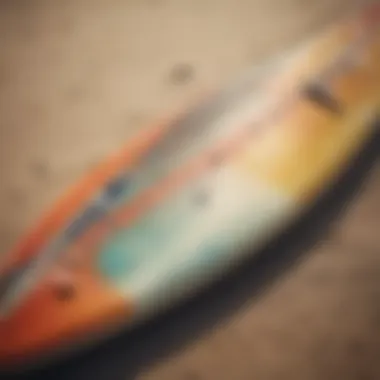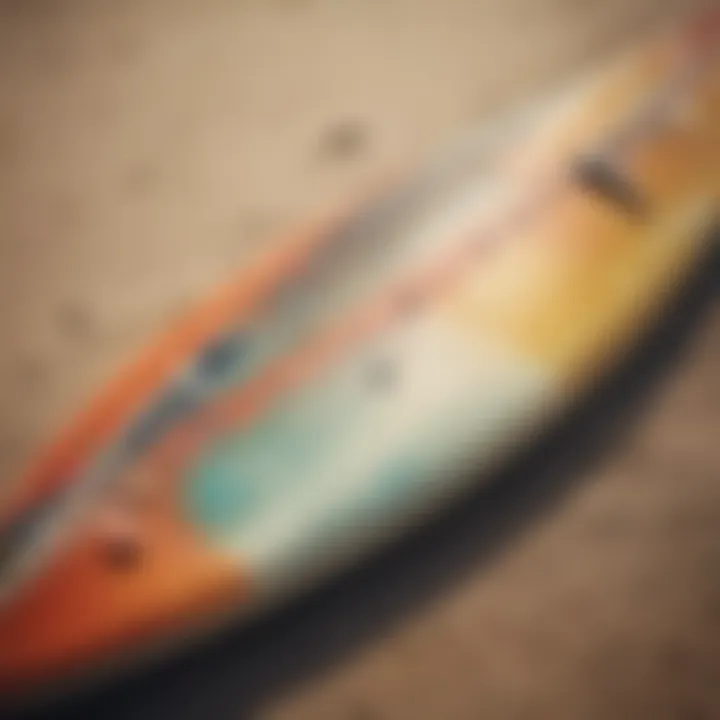Exploring the Retro Fish Surfboard: Design and Culture


Intro
The retro fish surfboard, a gem from the mid-20th century, carries more than just the essence of style; it’s a bridge to the cultural heartbeat of surfing history. A marvel in design and function, this surfboard type caters to both the adventurous spirit of seasoned surfers and the inquisitive nature of beginners. Its wide tail and unique outline allow for maneuverability and control, which makes it a favored choice among various surfing enthusiasts.
As we steer into this exploration, we will uncover the historical roots of the fish surfboard, tracing its evolution while shedding light on its significance in contemporary surf culture. We’ll delve into the craftsmanship that goes into creating these boards—artistry that combines both tradition and innovation. Alongside, we will touch upon its community, a vibrant tapestry woven with the threads of shared passion and the longing for the surf lifestyle.
By the end of our journey, you will gain a clearer perspective of what makes the retro fish surfboard not just a piece of equipment, but a cultural icon that continues to ride the waves.
Intro to the Retro Fish Surfboard
The retro fish surfboard stands as a beacon of creativity and innovation within the surfboard landscape. This section aims to illuminate the significance of this particular board, offering insights into its unique design elements, cultural relevance, and functional advantages. It’s not just about riding the waves; it’s about how this specific board has woven itself into the fabric of surfing culture.
Historically, fish surfboards upended traditional designs with their wider tails and overall squashed appearance, enabling surfers to navigate tricky wave conditions with increased agility. Unlike their longboard counterparts, which are reminiscent of a bygone era, the fish board captures a playful, almost rebellious spirit that appeals to both novice and veteran surfers alike.
Surfers benefit from fish boards in numerous ways. Primarily, their unique shape allows for short, fast turns without sacrificing stability. Riders find this especially advantageous in smaller, choppier waves where precision becomes key. Additionally, the fish surfboard often features a combination of twin or quad fin setups, which not only enhance speed but also optimize handling in diverse conditions.
Given their rising popularity, the retro fish surfboard also brings a sense of nostalgia, drawing in long-time enthusiasts while inviting a new generation to explore the surf world. Ultimately, examining the retro fish surfboard is not merely an analysis of its specifications; it is an exploration of a cultural icon that continues to ignite the passion of surf communities across the globe.
"The fish surfboard is a perfect blend of art and function, a true testament to the surf lifestyle that values freedom and expression."
Understanding its foundations enriches the surfing experience, enabling riders to appreciate the craft and culture that influences every wave they conquer.
Historical Overview
Understanding the historical backdrop of the retro fish surfboard is crucial for the audience that seeks a deeper appreciation of its significance in surfing culture. This section sheds light on how the fish surfboard came to be, evolving from a simple design into a cultural icon that resonates with surfers across generations. Why is it important? Well, it helps enthusiasts trace the lineage of surfboard shapes, fostering a connection that elevates the riding experience. By knowing its origins and changes over time, surfers can more fully engage with their equipment, acknowledging not just personal riding styles but also the collective heritage of surf culture.
Origins of the Fish Surfboard
The story of the fish surfboard kicks off in the late 1960s, when surf legend Bob McTavish and some of his contemporaries decided to shake things up. Tired of the standard longboards that ruled the waves, they sought a shorter, wider shape that would expand maneuverability and provoke creativity on the water. The quintessential feature of the fish surfboard is its swallowtail design, which allows surfers to cut through the waves with ease.
However, it wasn't just aesthetics that drove this design change. The advent of new materials, like fiberglass, also played a pivotal role. The lighter and more durable construction opened avenues for contemporary creations. Even back then, the fish surfboard articulated a departure from the ordinary. Its origins are steeped in a sense of adventure, driven by the restless spirits of those who wanted to ride the waves differently.
Evolution Through Decades
As we journey through the decades, the fish surfboard underwent significant transformations while maintaining its core identity. In the 1970s and 1980s, this surfboard type carved its niche firmly in the surfing scene. People began to take notice not just of its performance but also of its undeniably funky appearance. The 1990s brought about a renaissance. Many might say the decade marked the resurgence of interest in retro designs across various art forms, and surfing was no exception.
With the rise of new surfing styles, like progressive surfing and aerials, surfers began experimenting with modern interpretations of the fish. No longer confined to coastal niches, these boards graced breakwaters around the globe. This time, renowned shapers and designers explored innovative materials, heightening versatility and responsiveness.
Today, the retro fish surfboard is a beloved choice among surfers of all skill levels, flaunting a perfect blend of nostalgic appeal and enhanced performance. It stands as a testament to what can happen when a community pushes the boundaries of tradition, allowing the sport to evolve organically. The diversity of designs available now also reflects global influences, making each board a unique masterpiece that tells its own story.
"The fish surfboard is not just a piece of equipment; it is a reflection of the eras it has been a part of, blending history, technology, and culture into one thrilling ride."
By mapping these historical developments, one can appreciate the rich tapestry that makes up the retro fish surfboard's story, painting a picture that engages today's surfers as they connect to both the past and present.
Design Characteristics
The design characteristics of the retro fish surfboard are significant not just for their aesthetic appeal but also for their functional benefits. These surfboards are hallmarked by their unique shapes and materials, which together create a distinct riding experience. When considering elements such as width, length, thickness, and the materials used in construction, it becomes clear that each aspect plays a crucial role in both performance and visual style.
Unique Shape and Dimensions
Width
Width is often a defining feature in surfboard design, and with retro fish surfboards, it really gives them character. Wider boards tend to offer more volume, leading to increased stability in the water. This characteristic makes them an excellent choice for surfers looking for a reliable ride in various conditions. The extra width can facilitate a looser feel, allowing for easier turns, but might also sacrifice some speed in smaller waves.
In terms of specifics, most retro fish boards range between 20 to 24 inches wide. This range appeals to surfers who desire that sweet spot between stability and maneuverability. If one is looking to ride with a relaxed stance and still catch waves easily, this width certainly caters to those needs.
Length
The length of a retro fish surfboard plays equally a pivotal role in design. Typically, these boards are shorter than traditional longboards, usually falling in the range of 5 to 7 feet. This short length contributes to their playful nature, resulting in agile maneuvering and a fun ride. A shorter board tends to respond quicker, allowing for sharp turns and rapid rail-to-rail changes that can greatly enhance a surfer’s performance, especially in fast-moving waves.
However, one must consider that while shorter boards can be advantageous for experienced individuals, beginners may find it trickier to maintain balance. Yet, the charm of riding a fish lies in its capacity to facilitate creativity and spontaneity on the waves.
Thickness


Thickness, too, is an essential element that impacts buoyancy and paddle power. Retro fish surfboards often feature moderate to thicker profiles, usually around 2.5 to 3 inches. This dimension provides added flotation, making it easier to catch waves without excessive effort. A thicker profile is particularly beneficial for surfers who might struggle with the physical demands of paddling out.
On the downside, while added thickness contributes to buoyancy, it can invoke a feeling of bulkiness for some riders. This can potentially hinder tighter turns in fast-moving surf unless managed skillfully. But, for many, the trade-off of easier wave-catching capabilities outweighs any concerns about maneuverability.
Material Composition
Material selection in surfboard construction can drastically influence both durability and performance. For retro fish surfboards, three primary materials are often utilized: fiberglass, epoxy, and wood. Each material has its own set of attributes that make it suitable for different surfing needs.
Fiberglass
Fiberglass remains a popular choice when creating retro fish surfboards. Known for its strength and flexibility, this material can withstand the demands of various conditions. When applying fiberglass to a board, it usually results in a lightweight yet very durable finish.
The great thing about fiberglass is it can be shaped into infinite designs, allowing for that unique aesthetic appeal that many surfers love. However, its rigidity can be a drawback on softer waves, where riders might yearn for a bit more flex and responsiveness.
Epoxy
Epoxy surfboards are gaining traction for their lightweight structure and impressive durability. The material is composed of a resin that is resistant to dings and damage, making it a practical choice for surfers who value longevity.
Moreover, an epoxy board often floats better than traditional fiberglass alternatives, which can be advantageous for catching waves. However, it may come at a premium price, and some surfers feel it lacks the classic feel and responsiveness they’ve grown accustomed to with fiberglass boards.
Wood
Wooden fish surfboards have made a notable comeback given the recent focus on sustainability within the surfing community. A wooden board showcases artisan craftsmanship and provides a unique aesthetic appeal that can’t be replicated by synthetic materials.
The trade-off here is weight; wooden boards tend to be heavier compared to their fiberglass and epoxy counterparts. However, many find this to be a worthwhile investment both for the ride and for ecological considerations. Wooden boards provide a sort of nostalgic feel and offer sturdy performance in varied conditions, though maintaining them requires additional care.
Art and Aesthetics
Artistry plays a central role in the design of retro fish surfboards, affecting not just their visual impact but how a rider feels about their equipment. The colors, graphics, and artistic choices can ignite passion and individuality among surfers.
Color Schemes
Color is often one of the first things that attract surfers to a particular fish board. Bright, bold colors can make a statement on the waves and represent a surfer's personality. Customization options abound, giving enthusiasts the chance to select shades that resonate on a personal level.
Moreover, the choice of color can affect visibility in the water, thus, aiding in safety. Darker colors may heat up under sunlight but can also absorb water and become heavier if not treated properly. In essence, picking the right color scheme correlates with both style and practicality.
Graphic Designs
Graphic designs can also be a distinguishing factor for many surfboards. From straightforward designs to intricate graphic art that tells a story, the designs allow individuals to express their unique styles.
Some boards are graced with vintage logos or tribal patterns which can evoke a sense of history and tradition. Others may flaunt modern graphics that appeal to younger surf communities. Whatever the choice, aesthetic selection correlates strongly with maritime culture and personal identity, often leading to a stronger emotional attachment to the board.
Ultimately, these design elements work hand-in-hand with performance characteristics, forming a comprehensive package that appeals to diverse surfing preferences.
Cultural Significance
When we talk about surfboards, the retro fish is not just another piece of equipment; it is a cultural artifact deeply woven into the fabric of surfing history. This section delves into the role of the fish surfboard within surfing culture, exploring how it embodies not just a riding style, but a lifestyle and a community that spans generations. Its design, with its unique outline and performance characteristics, has made it a symbol of creativity and freedom among surfers. Within this vibrant culture, the fish surfboard holds a significant place that illustrates the evolution of not just board design, but the spirit of surfing as a whole.
The Fish Surfboard in Surf Culture
Iconic Status
The iconic status of the fish surfboard can be attributed to its striking design and performance capabilities. It is not just a board but a statement piece that reflects the surfer's personality. The wide tail and shorter length enhance maneuverability and speed, making it a popular choice for both professional and recreational surfers. This visual identity stands out on the waves, capturing the essence of what many view as the ideal surfing experience.
A key characteristic of its iconic status is the nostalgic element it brings, reminding surfers of the freedom of the past. The retro aesthetic appeals to those who appreciate vintage styles while still seeking functionality. However, while its unique design has many advantages, it may not suit every surfers' style, especially those who prefer more traditional longboards, which offer stability in bigger waves.
Influence on Surfing Styles
The influence on surfing styles cannot be overstated. As surfers embraced the fish surfboard, a distinct riding technique evolved. It encourages a more dynamic and agile approach to surfing, which empowers boarders to quickly cut through smaller, challenging waves. This shift has led to a resurgence of interest in shortboards and hybrid styles, allowing for creativity and personal expression on the water.
A pivotal aspect of this influence is its adaptability. Surfers find that the fish surfboard promotes a unique style known as "the glide," where the rider can elegantly dance across the wave rather than just riding it. The downside, however, is that new surfers may require time to adjust to these nuances, potentially feeling overwhelmed by the shift from traditional longboarding methods.
Revival in Popular Culture
Media Representation


The media representation of the retro fish surfboard plays a significant role in its resurgence within popular culture. From films like "Riding Giants" to various surf documentaries, the fish has become synonymous with the spirit of adventure and exploration in the surfing world. This reflects a broader trend where surf media has begun celebrating diversity in surfing styles and designs, thus breathing new life into the fish surfboard’s market and popularity.
This focus not only showcases the surfboard itself but also promotes the culture around it. Enthusiasts often share personal stories associated with their boards, creating a sense of camaraderie that resonates with a wider audience. Yet, while the representation is largely positive, some claim it's sometimes idealized, not fully capturing the challenges and nuances involved in truly mastering the fish.
Influencer Impact
The influencer impact on the fish surfboard's popularity has changed the landscape of surfing culture. Instructional videos and lifestyle content shared across platforms like Instagram and TikTok have brought incredible reach to the retro fish board's aesthetic and performance claims. Influencers harness their platform to inspire new generations of surfers, showcasing how engaging with a fish board can lead to unique experiences.
On one hand, this has led to an influx of newcomers looking to purchase fish surfboards, contributing to the industry’s growth. However, there's potential for negative implications like market saturation, where the influx of inexperienced surfers can lead to misrepresentations of the board’s capabilities.
With every turn of the tide, the retro fish surfboard continues to evolve, further solidifying its place within both surfing history and contemporary culture.
In summary, the cultural significance of the retro fish surfboard encapsulates its iconic status and influence on styles, along with its revival through media and influencer backing. For athletes and enthusiasts alike, understanding these dynamics offers insight into the ongoing narrative of surfing culture.
Performance Analysis
Performance analysis of the retro fish surfboard goes beyond mere statistics; it opens a window into understanding how design influences riding experience, adaptability to various wave conditions, and overall enjoyment in the water. Recognizing the nuances of performance allows surfers to not only optimize their choice of board but also tailor their surfing style. Key characteristics such as speed, agility, stability, and control play crucial roles in defining what makes the retro fish surfboard not just a choice, but a lifestyle for many.
Riding Experience
Speed and Agility
The speed and agility of a retro fish surfboard are often touted as its most appealing features. These boards, with their unique shape, allow surfers to glide swiftly across waves, which is a significant advantage in competitive settings or even just when you're trying to catch the perfect wave. The twin fin setup, commonly found on these boards, contributes to fast directional changes, allowing a rider to maneuver through faster swells with less effort. This responsiveness can often lead to a more exhilarating ride, as the surfer can push the limits with quick cuts and sharp angles.
One of the unique features of speed and agility in these boards is their shorter length combined with increased width. This design not only helps in maintaining momentum but also facilitates faster take-offs in smaller wave conditions, which many surfers find advantageous. However, while the increased speed can elevate the riding experience, it also means that control requires a certain level of skill, so beginners might find it a tad challenging to master.
Stability and Control
Stability and control are equally essential when it comes to the performance of a retro fish surfboard. For any surfer, having confidence in their board can make all the difference. The broader tail and the volume distributed throughout the body of these boards enhance stability, giving riders the ability to balance effectively, especially in choppy waters. This stability allows surfers to ride waves with a sense of safety, further enhancing their confidence in executing tricks or daring maneuvers.
As a characteristic of stability, the retro fish surfboard excels at maintaining a solid line while riding. This feature promotes smoother rides across varying wave conditions and makes it a favorite for those venturing into rougher waters. Nevertheless, it is worth noting that the inherent hybrid design may come with limitations in performance when targeting specialized higher-performance surf conditions, often requiring experienced riders to adapt their technique.
Wave Conditions
Best Suited Waves
Understanding the best suited waves for a retro fish surfboard is vital for maximizing performance. These boards shine in smaller, slower waves, making them a popular option for summer swells or fun beach breaks. The retro fish, with its wide nose and tail, provides excellent planing capabilities, allowing surfers to catch waves even when they are not pumping. This feature cultivates an enjoyable experience in conditions that might be less favorable for other board types.
The characteristic of adaptability in smaller waves comes from the fish's buoyant design. Surfers appreciate the ease of glide, making it possible for them to maintain speed while transitioning through different wave sections. However, it’s important to be mindful that while it thrives in smaller conditions, it may not perform well in large or powerful surf, where performance and precision become paramount.
Adaptability
The adaptability of retro fish surfboards is a noteworthy asset for surfers looking to expand their repertoire. These boards are not only tailored for smaller, mushy waves but can also handle varying conditions with the right rider mindset. Their design allows surfers to transition between types of riding, from cruising to more aggressive carving. This flexibility is appreciated by all surfers, from seasoned pros to adventurous beginners keen to explore.
Its adaptability arises from the combined features of a shorter body and a flared outline that enables quick transitions on the wave faces. However, a common downside is that less adaptation may lead to an uncomfortable experience in very high-performance environments, where dedicated boards specially made for those conditions can outshine the fish’s performance.
"The retro fish surfboard offers surfers a delightful mix of speed, stability, and adaptability that invites experimentation in various wave conditions, making it a cherished tool for those looking to push their limits."
In summary, performance analysis reveals that choosing the right retro fish surfboard has far-reaching implications for surfers, influencing not only their performance but also their overall enjoyment on the water.
Choosing the Right Retro Fish Surfboard
Choosing the right retro fish surfboard is like picking the ideal partner for a dance; it’s about compatibility, comfort, and style. The right board can elevate a surfer’s experience, enhancing every ride and making waves feel alive beneath them. With the retro fish surfboard’s unique design, it becomes crucial to consider certain elements like skill level, personal preferences, and the type of waves one intends to surf. This article’s aim is to break down these aspects, guiding surfers of all stripes toward a choice that suits their needs and aspirations.
Skill Level Considerations
Beginner vs. Experienced Surfers
When weighing beginner surfers against their more seasoned counterparts, it’s essential to highlight how skill level shapes their choice of surfboard. Beginners often benefit from wider boards with greater stability. These boards allow for easier paddling and catching waves. In contrast, experienced surfers may gravitate toward narrower boards that offer increased maneuverability but require a refined technique.
For novices, the retro fish surfboard can provide a forgiving ride, allowing them to develop confidence on the waves. Its unique shape offers stability, helping beginners maintain balance while learning to paddle and pop up. This characteristic makes it an appealing choice, especially for those just starting.
On the other hand, experienced surfers might see a different angle. Their focus on performance leads them to prefer fish surfboards that challenge their abilities, allowing for sharper turns and swift maneuvers. The key takeaway here is that while beginners seek comfort, experienced surfers chase thrill. Choosing between these two reflects the surfer's journey; each decision holds distinct advantages and disadvantages depending on one's level.
Personal Preferences


Riding Style
Riding style is a pivotal factor when selecting a retro fish surfboard. Some surfers relish carving tight turns with explosive power, while others might prefer a laid-back cruising experience. A surfer's style dictates not just their choice of board but also influences how they interact with the waves.
For aggressive riders, a shorter board with thruster fin setups can amplify their performance, providing agility and responsiveness. This approach rewards those who love to push boundaries and exploit the board's performance capabilities. Conversely, surfers who prefer smooth, flowing lines might opt for a longer retro fish surfboard, enhancing glide and stability on the wave face. Understanding one’s riding style is paramount, as it significantly shapes one’s overall experience.
Design Preferences
Design preferences matter too. Whether it’s the aesthetic appeal of a board or its technical specifications, surfers often find joy in the visual aspects. Picking the right colors or graphics not only reflects individual style but can also boost confidence while riding. For example, bold colors and artistic designs can make surfing feel like a statement, elevating the overall experience.
However, one must balance aesthetics with functionality. A surfer might be tempted to choose a beautifully crafted board that draws attention but perhaps sacrifices performance features like weight or tail shape. Thus, personal preference should align with the board's intended use. Choosing a surfboard is not merely a technical decision; it is about finding joy on the water and a connection to surfing culture.
Ultimately, choosing the right retro fish surfboard is a blend of multiple factors – skill level, riding style, and personal preferences all come together. For every surfer, there’s a perfect board waiting to elevate their experience out on the waves.
Maintenance and Care
Keeping a retro fish surfboard in prime condition is no small feat, but it’s absolutely essential for ensuring its longevity and performance. Much like a cherished classic car, a surfboard needs regular TLC to maintain its aesthetic appeal and functional capabilities. In this section, we’ll focus on two crucial aspects of surfboard care: cleaning and storage practices.
Cleaning Practices
Cleaning your retro fish surfboard should never be an afterthought. Saltwater, sand, and sun exposure can wreak havoc on your board’s surface if not addressed properly. Here are a few key cleaning tips to keep in mind:
- Rinse after use: Always rinse your surfboard with fresh water immediately after coming out of the ocean. This simple step removes salt residue and prevents corrosion on the fins and rails.
- Use mild soap: For deeper cleans, mix a mild soap with water. Avoid harsh chemicals or abrasive materials that can scratch the surface. Gently scrub with a soft sponge to clean away grime.
- Dry thoroughly: After washing, dry your board completely to avoid mildew formation. A microfiber towel works wonders for this and prevents lint stickiness.
Remember, taking these small steps can vastly improve the lifespan of your surfboard. Even if you’re fresh off the waves, spending a few extra minutes on cleaning will pay off big time in the long run.
Storage Guidelines
How you store your surfboard is just as important as how you clean it. Improper storage can lead to warps, dings, and other damage that can cut your surfing sessions short. Here are some best practices for storing your retro fish surfboard:
- Horizontal positioning: Store your surfboard horizontally on a rack or wall to prevent pressure points that cause warping. Avoid leaning it vertically against walls or furniture, as this can lead to unwanted dents.
- Temperature control: Keep your surfboard in a cool, dry place. Exposure to excessive heat can cause delamination and fading. Try your best to avoid leaving it in direct sunlight, especially in a vehicle.
- Use a board bag: Investing in a good-quality board bag can protect your surfboard from scratches and dings during transport and storage. Look for one with padding to ensure extra protection.
"Proper storage can save you a lot of headaches down the road by extending the life of your board and keeping it performance-ready."
The Future of Retro Fish Surfboards
As we look ahead, the retro fish surfboard continues to hold its place in the ever-evolving landscape of surfing. This section delves into future growth and development in the realm of retro fish surfboards. Significantly, understanding these future trends can empower both manufacturers and surfers to adapt and innovate according to market demands. The fusion of nostalgia with modern technologies is taking center stage, creating unique opportunities for surfboard enthusiasts.
Emerging Trends
When it comes to the future of retro fish surfboards, a few trends seem to glide to the forefront. One significant trend is the enhanced customization that boards now offer. Surfers can personalize their equipment, reflecting their own styles and preferences in designs that blend the vintage aesthetic with new technologies. The rise of online platforms has made it easier than ever for surfers and shapers to connect, creating a vibrant marketplace that showcases handmade, one-of-a-kind boards.
Moreover, the use of advanced materials is on the rise. Traditional fiberglass is now giving way to innovations like carbon fiber and bio-resins. These materials not only make boards lighter and more resilient but also enhance performance in challenging conditions. Surfers can expect to see boards that fulfill their need for speed while maintaining stability, preserving that beloved fish shape.
Lastly, with the growth of eco-conscious practices, many companies are steering their production towards sustainability. This not only meets the demands of environmentally aware surfers but also reflects a broader cultural shift towards responsible consumption. A surfboard that carries the ethos of sustainability alongside its iconic design can entice a new generation of surfers.
Sustainability Considerations
Sustainability plays a crucial role in shaping the future of the retro fish surfboard. As awareness about environmental issues rises, both manufacturers and consumers are compelled to consider the lifecycle of surfboards from production to disposal. Here are some key sustainability considerations:
- Materials Used: Sourcing eco-friendly materials such as recycled foam and sustainably harvested wood is vital. The quest for greener production methods can foster a new wave of design innovation that respects the environment.
- Production Processes: Adopting environmentally friendly practices in manufacturing is essential. Companies focusing on reducing waste and using energy-efficient techniques will attract environmentally conscious consumers.
- End-of-Life Options: Creatively addressing what happens to surfboards when they outlive their usefulness is becoming increasingly critical. Programs for recycling old surfboards or repurposing them into functional art or furniture can help minimize waste.
"As surfers, it’s not just about catching waves; it's about catching a future that respects the ocean and the environment we love."
The retro fish surfboard isn't just a relic of the past; it's a symbol of innovation and culture looking forward. With the right balance between tradition and modern advancements, the next chapter for these surfboards is poised to be as exciting as the waves they ride.
The End
In wrapping up our exploration of the retro fish surfboard, it’s vital to recognize not only its significance in surf culture but also the multifaceted ways it resonates with enthusiasts and novice riders alike. This unique board, with its distinctive design and performance characteristics, transcends mere utility; it’s a symbol of creativity, evolution, and community in the watersport scene.
The retro fish surfboard represents a blend of history and innovation. Its appeal lies in how it captures the essence of surfing from yesteryears while remaining relevant in today’s fast-paced surfing environment. Riders appreciate that it offers a short, wide design that allows for more maneuverability, particularly in smaller wave conditions. The speed and agility presented by this surfboard make it a favorite among those who revel in carving and performing tricks.
Moreover, the aesthetic choices available with these boards—ranging from vibrant color schemes to striking graphic designs—allow surfers to express their individual personalities, fostering a sense of identity and belonging within the surfing community. The team that crafts these boards invests considerable skill and passion, knowing that every detail contributes to not just performance but also to a rider's story.
It’s also important to recognize the role of sustainability as we move forward. As surfing embraces environmental stewardship, the evolution of materials and manufacturing processes will likely reflect a growing consciousness about our impact on the oceans.
As we gather insights from this article, seasoned athletes, outdoor instructors, and hobbyists can appreciate the retro fish surfboard, knowing its history, design intricacies, and the cultural narratives that come with it. Whether you’re an experienced surfer ready to ride the next wave or a newcomer eager to dip your toes in surfing’s rich waters, understanding the retro fish surfboard offers a deeper connection to the sport you love.
The retro fish surfboard is not just a piece of equipment; it’s a vessel of heritage, creativity, and community involvement.
In essence, the retro fish surfboard is a bridge linking the past with the present while paving the way for future innovations in design and sustainability. The journey into its depths enhances our appreciation not just for the board itself, but for a culture that cherishes the ocean and the camaraderie it fosters. Through thoughtful utilization and care, surfers can ensure that this beloved piece of surf history continues to inspire generations to come.















